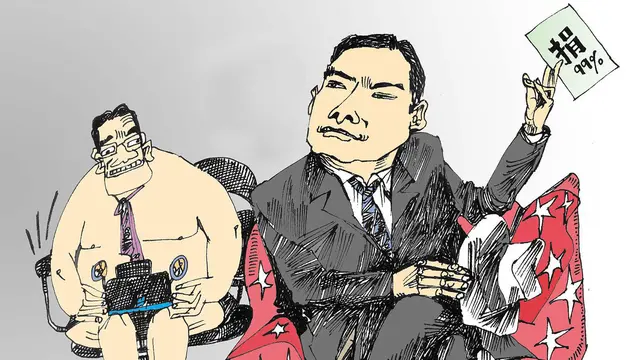By APD writer Mohammad Sohail
**KARACHI, May 16 (APD) ** -- Temperature was at 44 degree Celsius as scorching summer was getting its peak, but a Pakistani tailor Sheikh Bilal was sitting under a tree outside his shop, waving a handheld fan because there was no electricity for last four hours in his market at 6-Chak Stop area of Sahiwal district in Pakistan’s eastern Punjab province.
“Before 2009, my business was good, my two assistants and me could stitch up to five dresses in a day. Later, power crises started, we couldn’t work about 70 per cent of the time we spent in our shop. Even, if we used hand-run machines, we could stitch maximum two dresses in a day. I was not able to pay salaries to my employees, so I had to excuse them. My customers were also angry due to delay, and gradually I lost many of them,” said Bilal, 45, while talking to APD earlier this week.
On the other hand, in Pakistan’s southern port district of Karachi, some 900 kilometers away from Bilal’s shop, two big cooling towers with 162.5-meter height of each and a 195 meters long chimney are visible with hundreds of people working at different points of the under construction 1,320 megawatt Port Qasim Coal-Fired Power Project of China-Pakistan Economic Corridor (CPEC), a flagship project of China’s Belt and Road Initiative.
The project is one of the 21 energy cooperation projects backed by China and is the first coal-fired power project being constructed under the CPEC in Pakistan, with a number of others in pipeline.
The project, being controlled by the Port Qasim Electric Power Company (Private) Limited, located at the coastline of Arabian Sea, ranks first among the 11 early harvest projects under CPEC.
The Power Construction Corporation of China through its subsidiary PowerChina Resources Limited and Al-Mirqab Group Qatar possess holding of 51 per cent and 49 per cent shares of the 2.085 billion US dollar project respectively on Build-Own-Operate (BOO). The project is also partially funded by the Export-Import Bank of China.
Average annual energy output of the project will be around 9,000 Gigawatt, which is supposed to cut Pakistan’s current power shortfall by almost 20 per cent and to fulfil four million families’ power consumption for a year besides helping restart the closed industries, the officials said.
According to the National Electric Power Regulatory Authority (NEPRA) of Pakistan, the country’s average demand is over 22,000MW in summer season with a shortfall of 6,000MW.
During the peak summer season, the duration of load-shedding in urban areas is witnessed 12 to 14 hours, while rural areas face power off up to 20 hours. The long hours of load shedding have been causing unrest among masses who often hold rallies, mostly leading to violence by torching gov’t buildings.
Pakistani Prime Minister Nawaz Sharif performed the ground breaking of the project on May 7, 2015 followed by a 24 hours a day speedy work by 1,600 Pakistani engineers and workers under the guidance of their Chinese colleagues.
The project with two units of 660MW each, originally planned to be completed in three year, will start production well before time by the end of 2017 when its first unit of 660MW will start production while its second unit will be operational by March 2018.
The project has directly created more than 2,000 job opportunities for Pakistani workers during the peak of the construction phase, while it will also employ around 200 Chinese and up to 300 Pakistani trained professionals during operational stage.
The power plant, to be fueled by imported coal from Indonesia, Australia and Africa, adopts the world’s leading supercritical thermal technology and will also follow the environment-friendly operations, including seawater desalination and flue gas desulfurization.
Pakistan gov’t will purchase the electricity from the power plant at the upfront tariff of 8.12 U.S. cents per unit for 30 years.
Out of the total investment of 46 billion U.S. dollars from China under the CPEC, 34 billion U.S. dollars have been allocated for Pakistan’s energy sector only.
In addition to the Port Qasim Coal-fired Power Project, a number of power projects are under construction or being planned to start in different areas of the country, which would ease Pakistan’s rising energy demand in future.
In his speech recently, Chinese Ambassador to Pakistan, Sun Weidong said “Huge energy shortage was a bottleneck constraining Pakistan’s economic growth and people's lives, but the completion of 11 under process energy projects under CPEC will increase the electricity capital of about 11000MW, which will greatly ease the energy shortage and bring more vitality and dynamics to Pakistan’s economic development”.
“My family is suffering as we have less income now. We cannot sleep well because of hot and mosquitoes, my children cannot pay attention to their studies,” said Bilal adding “We have heard that Chinese gov’t is helping Pakistan to generate more and cheap electricity, we are sticking to this hope, and we believe China will do better for us”.
(ASIA PACIFIC DAILY)
 简体中文
简体中文

